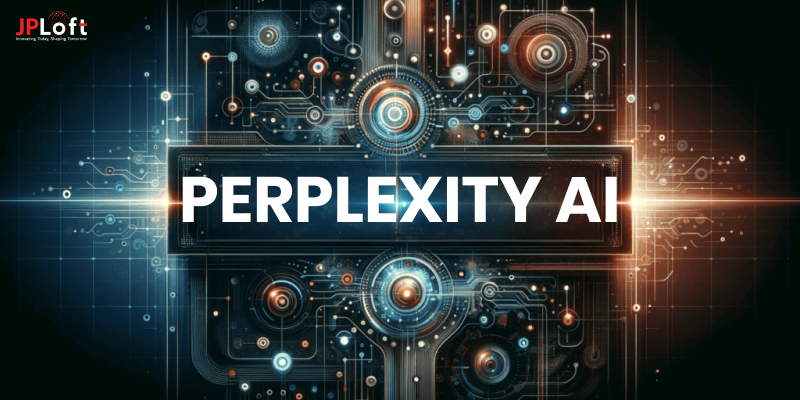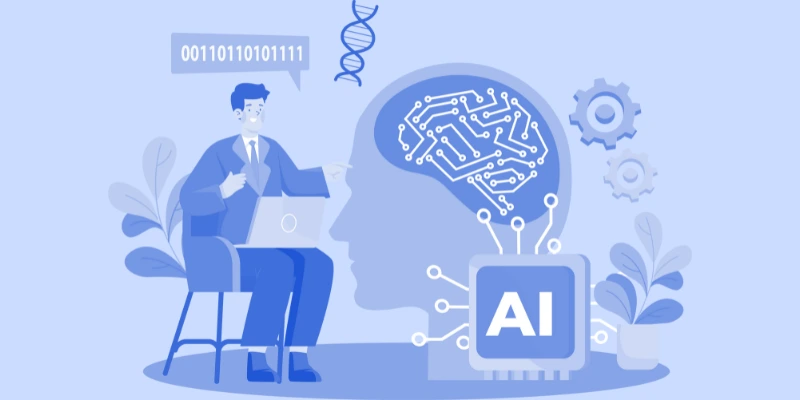Creating an AI-based system on your own is a challenging task, but when you have a proper strategy and basic knowledge, it works great.
This guide is perfect for beginners who want to explore AI development. However, the AI process covers theoretical and practical knowledge and thorough awareness of the possibilities and challenges that arise from AI development. Every step plays a vital role, from choosing the right methods to setting up and maintaining the AI Consulting system. This guide will cover important elements like the essentials of building an AI, the step-by-step procedures used, the most effective development methods, and the typical obstacles that arise while implementing the process.
Also Read: The Guide to Understanding and Using AI Models - 2024
What is AI?
Artificial Intelligence (AI) is the capacity of computers or machines to display human-like intelligence. Various technologies allow machines to think, perceive, behave, and learn like humans.
AI consulting systems are created to comprehend and recognize human behavior, make choices, and handle complex problems. AI systems can accomplish tasks like autonomously driving cars or using facial recognition to secure devices.
The AI world is a blend of technology, including machine learning, natural language processing, and computer vision. These technologies enable computer systems to understand and comprehend human language, learn from examples, and make well-informed predictions.
While each component of AI consulting is developing independently, its application in conjunction with other technologies, data analytics, and data automation could revolutionize business processes. From enhancing the efficiency of the supply chain to improving customer experience, AI offers transformative solutions for businesses to meet their goals more efficiently.
Must Read: 25+ AI Business Ideas to Consider in 2024
Process of Building An AI Platform
.webp)
Some fundamental elements are required to build the foundation of an AI system. The basis for an AI training process relies on quality data. Additionally, well-defined models or algorithms analyze this data. These could range from simple decision trees to sophisticated deep-learning networks.
Whether you use cloud-based servers on your premises, such as AWS or Google Cloud Platform, a robust infrastructure is required to help you train and implement an AI solution. Ultimately, the best way to connect the various elements is to thoroughly understand machine learning, programming languages (such as Python and R),statistical analysis,, and AI code.
Before proceeding with the details of the issue, it is equally crucial to realize that creating AI systems is different from the conventional programming process. However, AI tends to make changes to the software regularly.
Additionally, it is essential to understand that creating or developing any AI machine reduces costs and makes tasks more manageable. For example, Amazon Machine Learning is a perfect example that works with AI consulting and automatically categorizes products on its catalog using the item's description as its data.
Below are the steps to follow to create the foundation for an AI system:
Step 1. Problem Identification
The first step to developing a solid AI system is to identify the issue at the initial phase, asking questions such as "What outcome is desired?" and "What is the problem that is being attempted to solve here?" Another aspect that must be kept at the forefront is that AI isn't a panacea. It's an instrument that could be utilized to solve issues. Many different methods could be employed to tackle a particular issue using AI.
Step 2. Preparation of Data
The lengthy lines of code corresponding to the algorithm used are the basis of a sound AI consulting system. However, they are not. Data is an essential component in every AI toolkit. It is common for a data scientist to devote more than 80 percent of their time to cleaning, evaluating, arranging, and preparing the data to be used before writing one sentence of code.
So, before any model is run, the data must be examined for irregularities. Labels must be created, and a chronological sequence must be established. It is well-known that the more information sent to the data, the greater the chance of resolving the issue in time.
There are two types of data: both structured and unstructured.
Structured data: Data that has a standard format to guarantee consistency is referred to as structured data.
Unstructured Data: Any data that does not have a standard format, such as audio, images, files, or other files, is categorized as unstructured data.
Step 3. Choosing an Algorithm
This is the most critical or rewarding part of constructing the AI system. Without going into too many technical aspects, certain fundamental aspects must be considered when building the AI platform. Based on the kind of learning process, algorithms can alter the form it takes. There are two main ways to learn, described below:
Supervised learning is a term that requires the machine to be given an array of data that it can develop to provide the necessary results for the test data. Today, there are many algorithms for supervised learning, including SVM (Support Vector Machine) and Logistic Regression, Random Forest generation, Naive Bayes Classification, etc. One of the best ways to learn about the process of learning supervised by classification is to know the purpose behind our decision to gain insight into the particular loan, specifically when the information we seek is the probability of the loan defaulting.
Unsupervised Learning: This kind of learning differs from supervised learning due to the different algorithms used. These categories can be described as clustering, in which the algorithm attempts to classify objects; association, which tries to find the connections between objects; and dimensionality reduction, thus reducing the number of variables to lessen the noise.
Step 4. Learning the algorithms
Training the algorithm you have chosen is an essential step to ensuring its precision. After deciding on an algorithm, learning it is the next step in building an AI system. While there isn't a standard set of measures or international thresholds for accuracy for models, it is essential to ensure quality within the algorithm chosen.
Retraining and training are the most crucial aspects of constructing a functional AI system since it is inevitable that you may need to change the algorithm to ensure that the accuracy desired isn't achieved.
Step 5. The best language to use for AI
Many options are available for selecting the language to write the code and create AI systems. Moreover, numerous languages are available, such as classic C++ and Java, and more modern languages, such as Python and R. Python and R, are the most well-known choices for creating AI systems' code. Writing code and making decisions is quite simple, with Python and R featuring machine-learning libraries that can be used to create their models. A good library set means that you'll be able to spend less time writing algorithms and more time building models for the AI model. The NTLK, or natural language toolkit in Python, is an excellent library that allows users access to code written in advance instead of writing everything from scratch.
Step 6. Platform Selection
Pick the platform with all the required features for creating AI systems. So you don't have to buy everything separately. Ready-made platforms, such as machine training as a service, are fundamental and beneficial for expanding machine learning.
These platforms were designed to facilitate machine learning and assist in creating models. Popular platforms like Microsoft Azure Machine Learning, Google Cloud Prediction API, TensorFlow, and others help users with issues such as data processing modeling, training models, and predicting evaluation.
Read About: What is the Role of AI Consulting Services on Business
What is the Key Role of AI Consulting Companies?
AI consultants are your trusted advisors in designing, developing, building, and installing AI consulting systems. These systems allow you to make informed decisions to meet your desired business goals. They also assist in setting goals for your business, helping you stay ahead of competitors. Also, employees can learn to utilize AI tools to their maximum potential.
Strategic Architecture
AI consulting companies excel at creating AI plans tailored to the individual business. These blueprints guarantee that AI integrations align with the organization's overall goals and vision for the future.
Data Dynamics
Data plays a major role in this digital world. However, AI consultants are experts in analyzing data, transforming the raw data into valuable information that can inform decision-making.
A custom-designed AI fabrication
Every industry has its unique challenges. However, AI consultancies help to design bespoke AI solutions tailored to specific industry requirements to ensure effectiveness and relevancy.
Intellectual Capital Enhancement
To allow AI to be successful within an organization, the employees need to be skilled at managing it. Consulting firms offer comprehensive AI training, which transforms employees into AI-savvy experts.
Risk Terrain Navigation
Every AI consulting integration may involve risk. Consulting firms anticipate these risks by offering preventive arrangements and relief systems to guarantee a smooth progress.
Read Also: AI Revolution: How AI is Revolutionizing Technology
The Reasons for Syndicating With AI Consulting Company
Businesses of all sizes can access AI expertise and knowledge by collaborating with an AI consultancy company. This collaboration enhances the power of decision-making and ensures it is supported by expertise.
Financial Streamlining
Consulting AI consulting firms can pinpoint business issues, allowing them to benefit from financial efficiency. Unlocked, this leads to lower costs and boosted profits.
Agile Change
Consulting firms help businesses remain agile, advancing in line with AI advances and staying ahead of the competition.
Visionary preparedness
AI is not only about the present but also the future. AI Strategy Consulting also works on the upcoming technology trends and prepares businesses for what's to come to ensure longevity and relevance.
Final Thoughts
The ideal AI consultant combines the highest academic standards, practical experience, industry recognition, and a philosophy that matches the business's philosophy. These benchmarks help businesses in choosing the best AI consultancy company.
Recognizing the signs that a partnership with a consultant doesn't meet expectations is crucial. It could be due to mismatched AI goals, inadequate implementations, or a gap between the goals and communication.
The future will likely consist of perfect collaboration between AI and human beings. While AI continues to develop and offer valuable insights, Human consultants can improve AI's accuracy by bringing " context, creativity, and empathy."
In the vast web of technological advancement, AI consulting firms are web admins who reshape the direction and narrative of business through their AI initiatives. As AI's influence grows and its complexities become more complex, operating without the guidance of an expert can be risky. The function of AI consulting is not only important but crucial.





.webp)







Share this blog